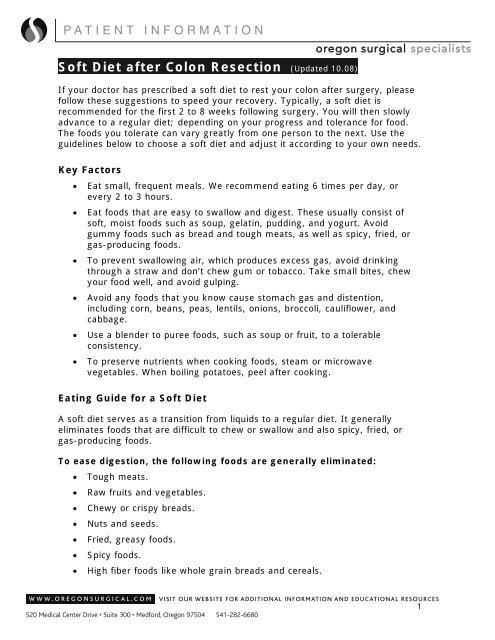Soft Diet after Colon Resection - Oregon Surgical Specialists
Soft Diet after Colon Resection - Oregon Surgical Specialists
Soft Diet after Colon Resection - Oregon Surgical Specialists
Create successful ePaper yourself
Turn your PDF publications into a flip-book with our unique Google optimized e-Paper software.
S<br />
PATIENT INFORMATION<br />
<strong>Soft</strong> <strong>Diet</strong> <strong>after</strong> <strong>Colon</strong> <strong>Resection</strong> (Updated 10.08)<br />
oregon surgical specialists<br />
If your doctor has prescribed a soft diet to rest your colon <strong>after</strong> surgery, please<br />
follow these suggestions to speed your recovery. Typically, a soft diet is<br />
recommended for the first 2 to 8 weeks following surgery. You will then slowly<br />
advance to a regular diet; depending on your progress and tolerance for food.<br />
The foods you tolerate can vary greatly from one person to the next. Use the<br />
guidelines below to choose a soft diet and adjust it according to your own needs.<br />
Key Factors<br />
• Eat small, frequent meals. We recommend eating 6 times per day, or<br />
every 2 to 3 hours.<br />
• Eat foods that are easy to swallow and digest. These usually consist of<br />
soft, moist foods such as soup, gelatin, pudding, and yogurt. Avoid<br />
gummy foods such as bread and tough meats, as well as spicy, fried, or<br />
gas-producing foods.<br />
• To prevent swallowing air, which produces excess gas, avoid drinking<br />
through a straw and don’t chew gum or tobacco. Take small bites, chew<br />
your food well, and avoid gulping.<br />
• Avoid any foods that you know cause stomach gas and distention,<br />
including corn, beans, peas, lentils, onions, broccoli, cauliflower, and<br />
cabbage.<br />
• Use a blender to puree foods, such as soup or fruit, to a tolerable<br />
consistency.<br />
• To preserve nutrients when cooking foods, steam or microwave<br />
vegetables. When boiling potatoes, peel <strong>after</strong> cooking.<br />
Eating Guide for a <strong>Soft</strong> <strong>Diet</strong><br />
A soft diet serves as a transition from liquids to a regular diet. It generally<br />
eliminates foods that are difficult to chew or swallow and also spicy, fried, or<br />
gas-producing foods.<br />
To ease digestion, the following foods are generally eliminated:<br />
• Tough meats.<br />
• Raw fruits and vegetables.<br />
• Chewy or crispy breads.<br />
• Nuts and seeds.<br />
• Fried, greasy foods.<br />
• Spicy foods.<br />
• High fiber foods like whole grain breads and cereals.<br />
WWW.OREGONSURGICAL.COM VISIT OUR WEBSITE FOR ADDITIONAL INFORMATION AND EDUCATIONAL RESOURCES<br />
520 Medical Center Drive • Suite 300 • Medford, <strong>Oregon</strong> 97504 541-282-6680<br />
1
Food<br />
Group<br />
Recommended Foods Foods to Avoid<br />
Beverages Milk<br />
Chocolate drinks<br />
Decaf tea<br />
Caffeinated drinks<br />
Powdered drink mixes<br />
Decaf coffee<br />
Non-citrus juices<br />
Carbonated drinks<br />
Alcohol<br />
Citrus juices<br />
Grains Ready to eat cereal<br />
Whole-grain breads and<br />
Refined bread<br />
cereals<br />
Crackers<br />
Anything with seeds, nuts,<br />
Plain white rice<br />
raisins, dried fruit, coconut<br />
Pasta<br />
Whole grain rice<br />
Pancakes and waffles<br />
Sweet rolls, coffee cake,<br />
donuts<br />
Seasoned crackers<br />
Popcorn<br />
Meats and Tender meat, pork, poultry, and fish Anything fried<br />
beans (baked, broiled, boiled, roasted, Tough meats with gristle<br />
stewed, or simmered)<br />
Smoked meats<br />
Eggs<br />
Sausage<br />
Tofu<br />
Shellfish<br />
Smooth peanut butter<br />
Fatty meats<br />
Cold cuts/lunch meat<br />
Fried eggs<br />
Dried beans<br />
Nuts and seeds<br />
Crunchy peanut butter<br />
Dairy Low-fat milk products<br />
Sharp/strong cheeses<br />
Smooth yogurt<br />
Dairy with nuts or seeds<br />
Mild cheese<br />
Cottage cheese<br />
Cheese with peppers<br />
Vegetables <strong>Soft</strong>-cooked or canned vegetables Raw vegetables, tomatoes,<br />
Fresh lettuce and tomato<br />
tomato sauce<br />
Potatoes without the skin<br />
Gas-producing vegetables:<br />
Peeled white or sweet potatoes broccoli, Brussels sprouts,<br />
(boiled, mashed, baked or cabbage, onions,<br />
creamed)<br />
cauliflower, corn, green<br />
peppers, cucumber,<br />
radishes, sauerkraut<br />
Dried beans, peas, and<br />
lentils<br />
Fried potatoes or potato<br />
chips<br />
Continued…<br />
2
Food<br />
Group<br />
Recommended Foods Foods to Avoid<br />
Fruit <strong>Soft</strong> raw fruits (without skin)<br />
Dried fruits<br />
Cooked and canned fruits<br />
Fruits with skins, seeds or<br />
Fruit juice<br />
pits, such as berries, figs or<br />
raisins<br />
All citrus fruits and juices<br />
Ripe bananas<br />
Coconut<br />
Fats and Ice cream, sherbet, and frozen Spicy salad dressings<br />
Sweets yogurt<br />
Bacon, bacon fat, ham fat,<br />
Pudding<br />
lard, salt pork<br />
Cake and cookies without hard Fried foods<br />
pieces<br />
Nuts<br />
Sugar, syrup, honey, jelly, seedless Anything with dried fruit,<br />
jam<br />
nuts, coconut, candied fruit<br />
Molasses<br />
Marshmallows<br />
Butter and margarine<br />
Mayonnaise and vegetable oils<br />
Mildly seasoned salad dressings,<br />
sauces, and gravies<br />
Plain cream cheese and sour cream<br />
Peanut brittle<br />
3


